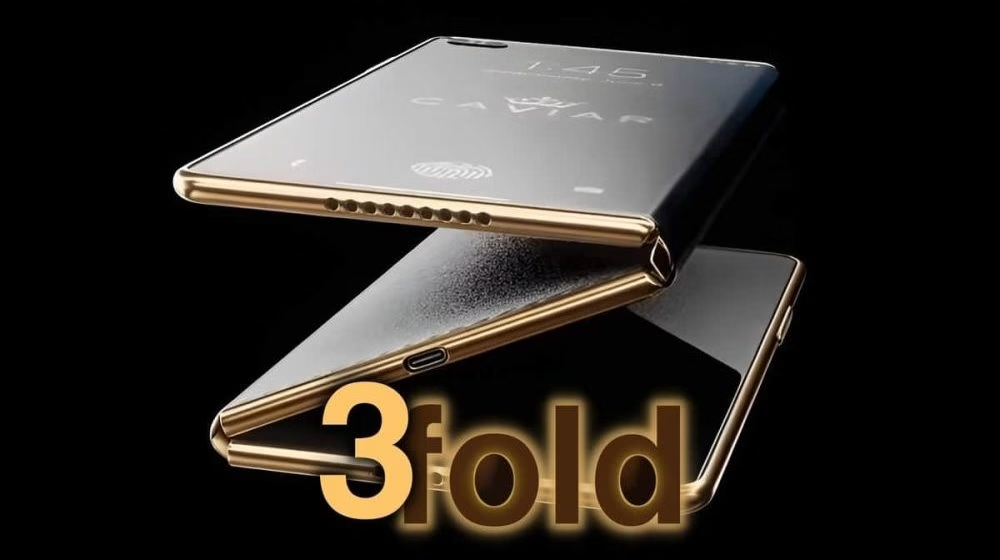Samsung is gearing up to launch its highly anticipated tri-fold smartphone in the third quarter of 2025, marking a bold step into the world of foldable devices. The upcoming device is expected to rival Huawei’s Mate XT, which has been one of the few competitors in the market offering a foldable smartphone with a unique design. Samsung’s new tri-fold smartphone is set to make waves, and here’s everything we know so far about its features, release date, and more.
Tri-Fold Design: A Unique Foldable Experience
Samsung’s tri-fold smartphone will showcase an innovative design that folds to protect its flexible screen when not in use. Unlike the Huawei Mate XT, which folds outward, the Samsung device will fold inwards, offering additional protection for the display. This design choice is a significant departure from the current foldable devices on the market, positioning Samsung as a pioneer in foldable technology.
When unfolded, the smartphone’s display will be impressively large, measuring between 9.9 inches and 10 inches. This would offer users a tablet-like experience, making it perfect for multitasking, media consumption, and gaming. The large screen could revolutionize how users interact with foldable smartphones, taking them closer to a true hybrid device that functions as both a phone and a tablet.
Launch Timing and Production Plans
Samsung plans to unveil the tri-fold smartphone at its annual foldable device event in July 2025, likely coinciding with the release of other foldable devices, including the Galaxy Z Fold 7 and Galaxy Z Flip 7. The launch is expected to occur in the third quarter of 2025, with production set to begin between April and June 2025.
Interestingly, Samsung has decided to limit the initial production run of the tri-fold smartphone to just 200,000 units. This cautious approach reflects the company’s acknowledgment that the tri-fold design is still an experimental product, and they want to test the waters before committing to large-scale production. While this might seem like a small number compared to other flagship releases, it indicates Samsung’s intention to gauge consumer interest and refine the device before expanding its availability.
The Foldable Device Lineup: Galaxy Z Fold 7 and Galaxy Z Flip 7
In addition to the tri-fold smartphone, Samsung will unveil four foldable devices in 2025. Alongside the tri-fold device, the Galaxy Z Fold 7 and Galaxy Z Flip 7 will be launched, continuing the company’s foldable lineup. These devices are expected to build on the success of their predecessors, with several upgrades to improve performance, durability, and overall user experience.
One significant change in the Galaxy Z Fold 7 is the removal of its digitizer, which will make the device thinner. This move is in response to competition from other foldable manufacturers like Oppo and Honor, which have focused on making their foldable devices thinner and more portable. By eliminating the digitizer, Samsung hopes to offer a sleeker, more competitive design that will appeal to users seeking a more compact foldable device.
The Galaxy Z Flip 7, on the other hand, will likely retain its compact, clamshell design, but with updated features and improvements. Samsung is expected to make subtle changes to enhance the user experience, particularly with regard to the device’s screen and hinge mechanism.
Affordable Options: Galaxy Z Flip FE
For consumers who want a more affordable foldable device, Samsung will also introduce the Galaxy Z Flip FE. This model will cater to those who desire a foldable smartphone but don’t want to spend as much as they would on the Galaxy Z Flip 7. To make it more affordable, Samsung will likely use the Exynos 2400e chipset, which offers a more budget-friendly option compared to the higher-end chips found in the Galaxy Z Fold 7 and Z Flip 7.
Chipset Details: Exynos 2500 for Premium Models
While Samsung has not officially confirmed the chipset for the tri-fold device, it is expected that the Galaxy Z Fold 7 and Z Flip 7 will be powered by the Exynos 2500. This chipset will be a key feature in Samsung’s 2025 foldable devices, offering improved performance and efficiency. Interestingly, the Exynos 2500 chipset was intentionally excluded from the Galaxy S25 series due to yield issues, but it will make its debut in the foldable lineup.
Samsung’s decision to use the Exynos 2500 in its foldable devices suggests that the company is prioritizing performance and efficiency in its high-end models. The Exynos 2400e, on the other hand, will be used in the Galaxy Z Flip FE to offer a more affordable yet still powerful alternative for users.
What’s Next for Samsung’s Foldable Devices?
As Samsung prepares to launch its new tri-fold smartphone in 2025, it’s clear that the company is committed to pushing the boundaries of foldable technology. With a unique design, large display, and cautious production strategy, the tri-fold smartphone has the potential to change the foldable device landscape.
The launch of the Galaxy Z Fold 7, Galaxy Z Flip 7, and Galaxy Z Flip FE will further cement Samsung’s position as a leader in the foldable smartphone market. By offering a variety of options at different price points, Samsung is ensuring that there’s something for everyone in its 2025 foldable lineup.



